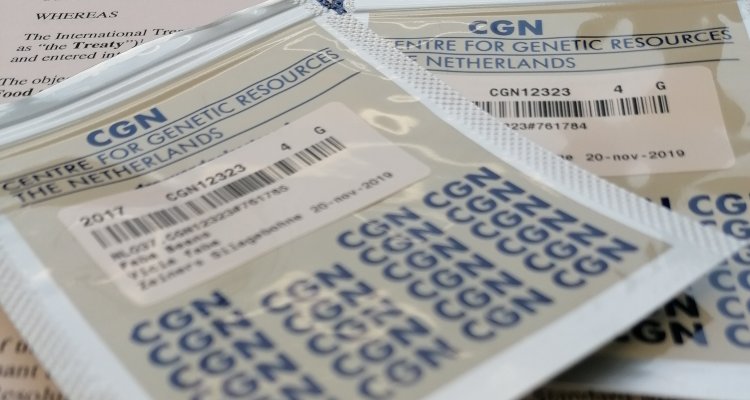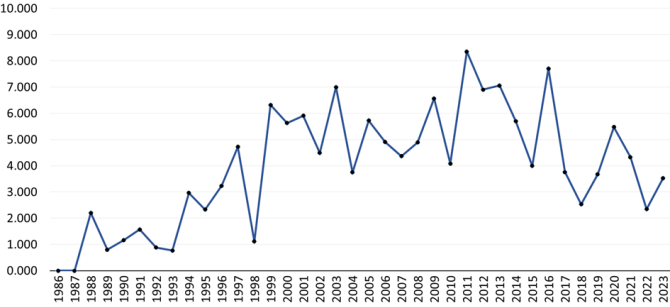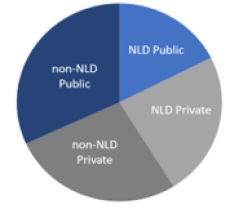
News
Lettuce and cabbage most popular crops in CGN plant genebank
The plant genebank of the Centre for Genetic Resources, the Netherlands (CGN) makes seed available for research, breeding and educational purposes. After an application for material and dealing with administration, CGN sends the seed to the applicant, either in the Netherlands or abroad. But how much material is actually requested? And which crops are most in demand?
The CGN manages collections of 33 crops, which are carefully curated and offer broad genetic diversity for each crop. A 'collection' includes a compilation of older and newer varieties of a crop, as well as wild species from the area of origin and local landraces. This material can be obtained during collecting missions, from plant breeding companies or by collaborating with foreign genebanks.
Which crops are popular?
Table 1 shows the numbers of samples distributed over the last 10 years by crop. This shows that lettuce, cabbage, chili/pepper and spinach are the most important crops for users. This is due to research and breeding activities in the Netherlands, which are distinctly focused on vegetables. Therefore, the CGN also focuses on these crops.
| Crop | #Samples | Percentage |
|---|---|---|
| Lettuce | 8,029 | 18.5% |
| Brassicas | 7,126 | 16.4% |
| Chili/pepper | 5,303 | 12.2% |
| Spinach | 5,081 | 11.7% |
| Tomato | 3,111 | 7.2% |
| Wheat | 3,051 | 7.0% |
| Cucumber family | 1,855 | 4.3% |
| Potato | 1,762 | 4.1% |
| Eggplant | 1,567 | 3.6% |
| Onions | 1,454 | 3.4% |
| Remainder | 4,989 | 11.5% |
Table 1. Top 10 crops requested most from the CGN between 2014 and 2023, with the amount of requests (#Samples) and the proportion (Percentage) of all requests per crop.
The Wageningen lettuce collection is probably the most complete and well-balanced in the world. But also the other CGN crop collections are carefully curated, well documented and, very importantly, always available for shipment. This is why the CGN is popular with vegetable seed users: you know what you are getting and you know THAT you are getting it.
Applications since 1986
The CGN has kept track of all issues of requested seeds since its inception. Figure 1 shows the number of sent samples ('accessions' in genebank terms) per year. It shows that there is considerable fluctuation between years. The peaks are often related to large research projects, where a high number of accessions from one or more collections were investigated. The number of answered requests for material is more constant and is roughly between 150 and 250 per year.

The CGN only handles requests from bona fide applicants, where the material is for research, breeding and educational purposes. Moreover, all requests for more than 50 different accessions will first be discussed with the applicant. If it concerns research where a large number of accessions are definitely necessary, a request will be made to share the results of the research (possibly after an embargo period) with the CGN, and thus with the world.
User segmentation

The CGN serves the whole world. Figure 2 shows that over the last decade, 59% of the material went abroad, of which 32% went to other European countries. The remaining 17% of foreign requests went to Asia and 10% to the rest of the world.
This figure also shows that about half (49%) of the material is sent to public institutions, especially universities. The reamining users consist of private institutions, predominantly breeding companies.
Importance for the future
Seed distribution helps spread genetic variation of crops grown in the Netherlands and abroad, which is essential for research and breeding. This supports the development of crops that are more resistant to challenges such as extreme weather conditions or disease, for now and for future generations. Besides the current collections, the CGN is working on building new crop collections, such as those of carrot, parsnip, beetroot and fennel, to serve even more users interested in this material.
This article was written by Theo van Hintum and Lana de Bruijn, Centre for Genetic Resources Netherlands (CGN)